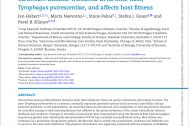Obsah
Interactions among endosymbiotic bacteria inside their eukaryotic hosts are poorly understood, particularly in mites. The mite Tyrophagus putrescentiae is a common, medically important generalist species that has many intracellular and gut bacterial symbionts. In the experiments, we examined bacterial abundances and composition in mite populations obtained by controlled mixing of stock mite populations that differed in the presence/absence of the major intracellular bacteria Wolbachia and Cardinium. Changes in microbial communities were characterized using 16S ribosomal RNA high-throughput sequencing (pooled mite individuals) and quantitative PCR for key microbial taxa (individual mites). Mite fitness was estimated as a parameter of population growth. We detected that in mixed mite populations, Cardinium and Wolbachia can
co-occur in the same mite individual. The presence of Cardinium was negatively correlated with the presence of Wolbachia and Bartonella, while the Bartonella and Wolbachia were positively correlated in individual level samples. Since mixed populations had lower abundances of Wolbachia, while the abundance of Cardinium did not change, we suggest that the presence of Cardinium inhibits the growth of Wolbachia. The mixed mite populations had lower population growth than parental populations. The possible effect of symbionts on the fitness of mixed population is discussed.
co-occur in the same mite individual. The presence of Cardinium was negatively correlated with the presence of Wolbachia and Bartonella, while the Bartonella and Wolbachia were positively correlated in individual level samples. Since mixed populations had lower abundances of Wolbachia, while the abundance of Cardinium did not change, we suggest that the presence of Cardinium inhibits the growth of Wolbachia. The mixed mite populations had lower population growth than parental populations. The possible effect of symbionts on the fitness of mixed population is discussed.



